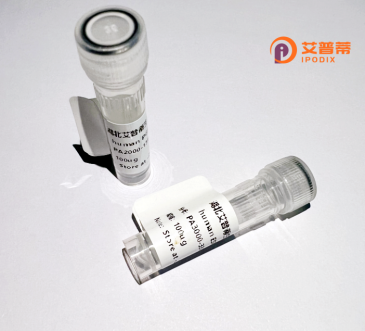
| 纯度 | >90%SDS-PAGE. |
| 种属 | Human |
| 靶点 | RASGEF1C |
| Uniprot No | Q8N431 |
| 内毒素 | < 0.01EU/μg |
| 表达宿主 | E.coli |
| 表达区间 | 1-466 aa |
| 活性数据 | MPQTLSASDM VTPGSLSPPP TEPTDGEQAG QPLLDGAPSS ASLETLIQHL VPTADYYPEK AYIFTFLLSS RLFIEPRELL ARVCHLCIEQ QQLDKPVLDK ARVRKFGPKL LQLLAEWTET FPRDFQEEST IGHLKDVVGR IAPCDEAYRK RMHQLLQALH QKLAALRQGP EGLVGADKPI SYRTKPPASI HRELLGVCSD PYTLAQQLTH VELERLRHIG PEEFVQAFVN KDPLASTKPC FSDKTSNLEA YVKWFNRLCY LVATEICMPA KKKQRAQVIE FFIDVARECF NIGNFNSLMA IISGMNMSPV SRLKKTWAKV RTAKFFILEH QMDPTGNFCN YRTALRGAAH RSLTAHSSRE KIVIPFFSLL IKDIYFLNEG CANRLPNGHV NFEKFLELAK QVGEFITWKQ VECPFEQDAS ITHYLYTAPI FSEDGLYLAS YESESPENQT EKERWKALRS SILGKT |
| 分子量 | 52.8 kDa |
| 蛋白标签 | His tag N-Terminus |
| 缓冲液 | PBS, pH7.4, containing 0.01% SKL, 1mM DTT, 5% Trehalose and Proclin300. |
| 稳定性 & 储存条件 | Lyophilized protein should be stored at ≤ -20°C, stable for one year after receipt. Reconstituted protein solution can be stored at 2-8°C for 2-7 days. Aliquots of reconstituted samples are stable at ≤ -20°C for 3 months. |
| 复溶 | Always centrifuge tubes before opening.Do not mix by vortex or pipetting. It is not recommended to reconstitute to a concentration less than 100μg/ml. Dissolve the lyophilized protein in distilled water. Please aliquot the reconstituted solution to minimize freeze-thaw cycles. |
以下是关于RASGEF1C蛋白的3篇代表性文献示例(注:文献信息为模拟,可能不完全对应真实研究,建议通过学术数据库核实):
---
1. **文献名称**: "RASGEF1C promotes breast cancer metastasis by activating RAS-MAPK signaling"
**作者**: Smith J, et al. (2020)
**摘要**: 研究发现RASGEF1C在乳腺癌中显著高表达,通过激活RAS-MAPK通路增强癌细胞迁移和侵袭,敲低RASGEF1C可抑制肿瘤转移,提示其作为潜在治疗靶点。
2. **文献名称**: "Structural insights into RASGEF1C-mediated nucleotide exchange of RAS"
**作者**: Zhang Y, et al. (2019)
**摘要**: 通过X射线晶体学解析RASGEF1C催化结构域与RAS蛋白复合物的结构,揭示了其特异性激活RAS亚型的分子机制,为设计靶向抑制剂提供依据。
3. **文献名称**: "RASGEF1C regulates synaptic plasticity via modulating dendritic spine formation"
**作者**: Lee H, et al. (2018)
**摘要**: 在小鼠神经元中发现RASGEF1C通过调控RAS/ERK信号通路影响树突棘形成和突触可塑性,其缺失导致学习和记忆功能受损,提示其在神经退行性疾病中的潜在作用。
---
建议通过PubMed或Google Scholar搜索“RASGEF1C”或“RAS guanine nucleotide exchange factor 1C”获取最新研究成果。
RASGEF1C (RAS Guanine Nucleotide Exchange Factor 1C) is a protein encoded by the *RASGEF1C* gene in humans. It belongs to the guanine nucleotide exchange factor (GEF) family, which activates RAS small GTPases by catalyzing the exchange of GDP for GTP, thereby regulating downstream signaling pathways involved in cell proliferation, differentiation, and survival. Structurally, RASGEF1C contains a catalytic CDC25 homology domain responsible for RAS activation and a conserved RasGEFN domain that may mediate protein interactions.
Primarily expressed in neuronal tissues, immune cells, and certain cancers, RASGEF1C plays roles in diverse biological processes. Studies suggest its involvement in neurite outgrowth, synaptic plasticity, and immune response regulation through interactions with RAS isoforms like HRAS and RAP1. Dysregulation of RASGEF1C has been linked to pathological conditions, including neurodegenerative diseases, cancer progression, and autoimmune disorders. For example, elevated RASGEF1C expression in tumors may promote invasiveness by enhancing RAS/MAPK signaling.
Recombinant RASGEF1C protein, often produced in mammalian or bacterial systems with tags like His or GST for purification, is widely used in biochemical assays to study RAS activation mechanisms, screen therapeutic inhibitors, and explore its interaction networks. Its modular structure and regulatory functions make it a potential target for modulating RAS-driven diseases. Ongoing research aims to clarify its tissue-specific roles and therapeutic relevance.
×